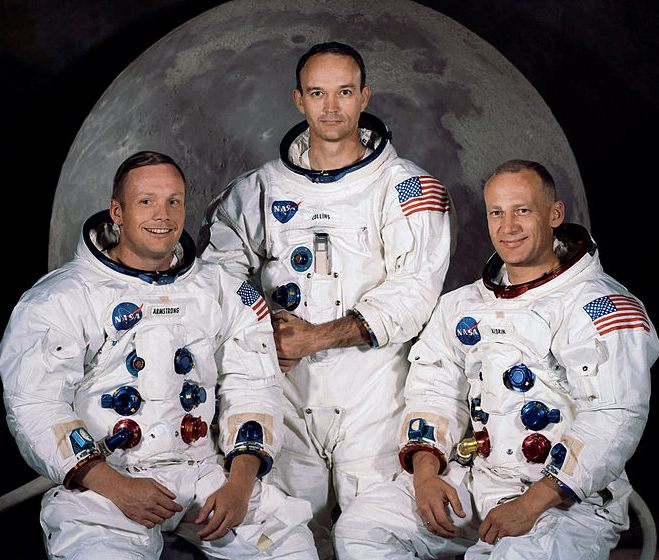|
The Apollo program was the third human spaceflight program carried out by the National Aeronautics and Space Administration
(NASA), the United
States' civilian space agency. First conceived during the Presidency of Dwight D. Eisenhower as a three-man spacecraft to follow the one-man Project Mercury which put the first Americans in space, Apollo was later dedicated to President John F. Kennedy's national goal of "landing a man on the Moon and returning him safely to the Earth" by the end of the 1960s, which he proposed in a May 25, 1961 address to
Congress. Project Mercury was followed by the two-man Project Gemini (1962–66). The first manned flight of Apollo was in 1968 and it succeeded in landing the first humans on Earth's Moon in 1969 through 1972.

Kennedy's goal was accomplished on the Apollo 11 mission when astronauts Neil Armstrong and Buzz Aldrin landed their Lunar Module (LM) on the Moon on July 20, 1969 and walked on its surface while Michael Collins remained in lunar orbit in the command spacecraft, and all three landed safely on Earth on July 24. Five subsequent Apollo missions also landed
astronauts on the Moon, the last in December 1972. In these six spaceflights, 12 men walked on the Moon.
Apollo ran from 1961 to 1972, and was supported by the two-man Gemini program which ran concurrently with it from 1962 to 1966. Gemini missions developed some of the space travel techniques that were necessary for the success of the Apollo missions. Apollo used Saturn family
rockets as launch vehicles. Apollo / Saturn vehicles were also used for an Apollo Applications program which consisted of three Skylab space station missions in 1973–74.

Apollo succeeded despite the major setback of a 1967 Apollo 1 cabin
fire that killed the entire crew during a pre-launch test. Six manned landings on the Moon were achieved. A seventh landing mission, the 1970
Apollo 13 flight, failed in transit to the
Moon when an oxygen tank explosion disabled the command spacecraft's propulsion and life support, forcing the crew to use the Lunar Module as a
"lifeboat" for these functions to return to Earth safely.
Apollo set several major human spaceflight milestones. It stands alone in sending manned missions beyond low
Earth orbit; Apollo 8 was the first manned spacecraft to orbit another celestial body, while the final Apollo 17 mission marked the sixth Moon landing and the ninth manned mission beyond low Earth orbit. The program returned 842 pounds (382 kg) of lunar rocks and soil to Earth, greatly contributing to the understanding of lunar geology. The program laid the foundation for
NASA's current human spaceflight capability, and funded construction of its Johnson Space Center and Kennedy Space Center. Apollo also spurred advances in many areas of technology incidental to rocketry and manned spaceflight, including avionics, telecommunications, and computers.
LINKS
http://www.nasa.gov/
http://www.house.gov/
AVIATION
A - Z

A
Bluefish ZCC can be configured to carry the Scorpion
anti pirate weapon, or operate as a fully fledged micro
destroyer. A fleet of such autonomous vessels could be
the basis of an international peacekeeping, and/or emergency
rescue force. The
navigation system that is being developed for the Bluefish
range could have prevented the sinking of the Costa
Concordia. This
might be of interest to fleet operators. A further development
of the concept, is an ocean going vacuum cleaner called SeaVax,
the mission being to clean up plastic waste.
|


